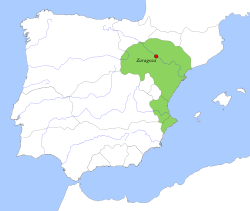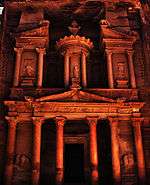Taifa of Zaragoza
The taifa of Zaragoza (Arabic: طائفة سرقسطة) was an independent Arab[1][2][3] Muslim state in the east of Al-Andalus (present day Spain), which was established in 1018 as one of the taifa kingdoms, with its capital in Saraqusta (Zaragoza) city. Zaragoza's taifa emerged in the 11th century following the destruction of the Caliphate of Córdoba in the Moorish controlled Iberian Peninsula.
Taifa of Zaragoza | |||||||||
|---|---|---|---|---|---|---|---|---|---|
| 1013–1110 | |||||||||
 Taifa Kingdom of Zaragoza, c. 1080 | |||||||||
| Capital | Zaragoza | ||||||||
| Common languages | Arabic, Mozarabic, Hebrew, Berber | ||||||||
| Religion | Islam, Christianity (Roman Catholic), Judaism | ||||||||
| Government | Monarchy | ||||||||
| Historical era | Middle Ages | ||||||||
• Downfall of Caliphate of Cordoba | 1013 | ||||||||
• Conquered by the Almoravids | 1110 | ||||||||
| Currency | Dirham and Dinar | ||||||||
| |||||||||
| Historical Arab states and dynasties | ||||||||||||||||||||||||||||||||||||||||||||||||||||||||||
|---|---|---|---|---|---|---|---|---|---|---|---|---|---|---|---|---|---|---|---|---|---|---|---|---|---|---|---|---|---|---|---|---|---|---|---|---|---|---|---|---|---|---|---|---|---|---|---|---|---|---|---|---|---|---|---|---|---|---|
 | ||||||||||||||||||||||||||||||||||||||||||||||||||||||||||
|
Ancient Arab States
|
||||||||||||||||||||||||||||||||||||||||||||||||||||||||||
|
Arab Empires
|
||||||||||||||||||||||||||||||||||||||||||||||||||||||||||
|
Eastern Dynasties
|
||||||||||||||||||||||||||||||||||||||||||||||||||||||||||
|
Western Dynasties
|
||||||||||||||||||||||||||||||||||||||||||||||||||||||||||
|
Arabian Peninsula
|
||||||||||||||||||||||||||||||||||||||||||||||||||||||||||
|
East Africa
|
||||||||||||||||||||||||||||||||||||||||||||||||||||||||||
|
Current monarchies
|
||||||||||||||||||||||||||||||||||||||||||||||||||||||||||
| Wikimedia Commons has media related to Taifa of Zaragoza. |
During the first three decades of this period (1018–1038), the city was ruled by the Arab Banu Tujib tribe. They were replaced by the Arab Banu Hud rulers, who had to deal with a complicated alliance with El Cid of Valencia and his Castilian masters against the Almoravids, who managed to bring the Taifas Emirates under their control. After the death of El Cid, his kingdom was conquered by the Almoravids, and by 1100 they had crossed the Ebro into Barbastro, which brought them into direct confrontation with Aragon.
The Banu Hud stubbornly resisted the Almoravid dynasty and ruled until they were eventually defeated by the Almoravids in May 1110. The last sultan of the Banu Hud, Abd-al-Malik, and Imad ad-Dawla of Saraqusta, were forced to abandon the capital. Abd-al-Malik allied himself with the Christian Aragonese under Alfonso I of Aragon and from then on the Muslim soldiers of Saraqusta served in the Aragonese forces.
Between c. 1040 and c. 1105, the Taifa of Lérida was separate from that of Zaragoza.
List of Emirs
Tujibid dynasty
- Mundir I al-Tuybi al-Mansur: c. 1013–1021/2
- Yahya: 1021/2–1036
- Mundir II: 1036–1038/9
- Abd Allah ibn al-Hakam al-Tujibi: 1038/9
Huddid dynasty
- Suleiman Al-Mustain I ibn Hud: 1038/9–1046
- Muhammad al-Hayib Adud ad-Dawla (Calatayud): 1046/7–1066/7 with...
- Lubb (Huesca): 1047–1048 and...
- Mundir al-Hayib al-Zafir Nasir ad-Dawla (Tudela): 1047–1048/9 and...
- Yusuf al-Muzaffar Sayf ad-Dawla (Lérida): 1047–1078/81 and...
- Abu Ya'far Ahmad al-Muqtadir: 1046–1081 or 82/3
- Yusuf al-Mu'tamin: 1081 or 82/3–1085
- Ahmad II al-Musta'in: 1085–1110
- 'Abd al-Malik Imad ad-Dawla (Rueda, Z. 1110 only): 1110–1130
- Abu Dja'far Ahmad Zafadola (Rueda. In Val. 1146): 1130–1131, d. 1146
Almoravid dynasty
- Muhammad ibn al-Hajj: 1110–1115
- ibn Tifalwit: 1115–1117
- Rueda to Castile 1130
See also
- Taifa
- Al-Andalus
- Granada
- History of Islam
- History of Spain
- List of Sunni Muslim dynasties
References
- John Middleton (1 June 2015). World Monarchies and Dynasties. Taylor & Francis. p. 925. ISBN 978-1-317-45157-0.
- William D. Phillips, Jr; Carla Rahn Phillips (1 July 2010). A Concise History of Spain. Cambridge University Press. p. 64. ISBN 978-0-521-60721-6.
- Simon Barton (14 October 2004). "6: Spain in the Eleventh Century". In David Luscombe, Jonathan Riley-Smith (ed.). The New Cambridge Medieval History: Volume 4, C.1024-c.1198. IV. Cambridge University Press. p. 157. ISBN 978-0-521-41411-1.